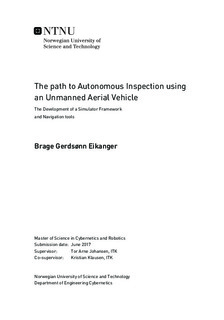The path to Autonomous Inspection using an Unmanned Aerial Vehicle - The Development of a Simulator Framework and Navigation tools
Abstract
Using unmanned aerial vehicles for autonomous inspections of industrial environments in general, and cargo holds and tanks in particular, is a goal that has become within reach the last couple of years, though a lot of development still remains. A problem when developing for inspection of cargo holds is the lack of real world testing opportunities, slowing down development. In this thesis a simulation framework has been developed to speed up the development of autonomous inspection. Furthermore, navigation tools needed for autonomous flight has been implemented and tested within the framework. The simulation framework uses the Gazebo simulator and the Robot Operating System environment to create a framework which focuses on clean interfaces, ease of use, and portability to real world usage. The navigation tools developed were a collision avoidance algorithm and a Simultaneous Localisation And Mapping (SLAM) algorithm, both relying on a 2d-scanning lidar. Being tested in the simulator, the navigation tools performed well, both in normal surroundings and that of a cargo hold, though the size and openness of the cargo hold made the performance very reliant on the range of the lidar. Through the development and testing of the navigation tools, the simulation framework itself was tested and proved to be a valuable and useful resource, providing a flexible and modular interface, which helped the ease of development and speed of testing significantly.
